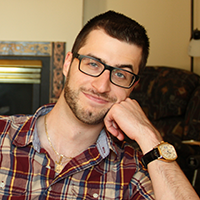 Jonathan L. Moscovici is a biostatistician at Quintiles, the world’s largest contract research organization. He holds a master’s degree in mathematics and statistics from McGill University in Montréal, Québec, Canada. He co-authored a chapter in the book Big Data and Health Analytics and is a member of the Accreditation Services Committee for the Statistical Society of Canada. He has consulted in academic, hospital, and industry settings.
Jonathan L. Moscovici is a biostatistician at Quintiles, the world’s largest contract research organization. He holds a master’s degree in mathematics and statistics from McGill University in Montréal, Québec, Canada. He co-authored a chapter in the book Big Data and Health Analytics and is a member of the Accreditation Services Committee for the Statistical Society of Canada. He has consulted in academic, hospital, and industry settings.
Let’s face it; your ninth-grade teacher was right. Math is cool. There are more opportunities available than ever before, and it’s challenging for aspiring graduates to steer themselves in the direction that’s right for their own goals and interests. I’d like to share a few of my experiences as a biopharmaceutical statistician that I didn’t really know (but wish I did) as a grad student.
The pharmaceutical industry is as complicated as it is interesting, and it’s plenty interesting. A colossal amount of work and money goes into bringing a newly discovered compound to market, and that’s only if it works well (“efficacy”) without intolerable side effects (“safety”).
Many variables factor into decisions regarding clinical research, so it’s difficult for a newcomer to get a decent snapshot of how it all works. In recent times, CROs (contract research organization) and FSPs (functional service providers) have become popular choices for major pharma companies that outsource a lot of the drug development process (e.g., data management, biostatistics, etc.).
In the past, a drug company (called “sponsor”) would discover a compound and then handle all the research tasks on its own, in-house. However, that’s a big hassle, particularly from a resourcing perspective, since you never know how many people you might need to have on staff at the exact moment you want to send a drug down the pipeline. That’s where CROs come in. A CRO can be contracted by sponsors to climb on board and offer a specialized set of services depending on the needs of the trial. That’s where I work.
In some cases, the role of biostatistician can exist both on the sponsor side and at the CRO. Under this set-up, each clinical trial would have a biostatistician assigned at both companies. These counterparts would collaborate to produce the outputs and analyses required. This can include protocol consulting and SAP (statistical analysis plan) development. Every partnership is different, so the distribution of work varies, but you don’t even realize the research team members belong to separate companies in the best of cases.
The alternative would be biostatistics being completely outsourced to the CRO.
What Should Students Do?
A common issue is that many students find it difficult to break into the industry (assuming they are even aware of it). It’s the classic problem of needing experience to get hired, but not being able to gain experience because no one will hire you. However, certain skills can help land the entry-level positions that do exist.
First, learn SAS. I know R is cool because it’s open source and a fantastic research tool. It’s also the favorite programming language in many math and stats departments, and so students are not necessarily encouraged to learn SAS. However, SAS is pretty much an industry standard in pharma (and many other industries). In fact, SAS programmers on their own are highly employable, have high job satisfaction, and work closely with biostatisticians (this is actually how many people, including me, started out).
Second, students should inform themselves as much as possible about the drug process. A strong command of CDISC standards, ICH regulations, and clinical trial phases (I-IV) is part of the biostatistician’s toolbox. Questions about how data are collected, processed, and delivered are nontrivial. If not covered in your curriculum, a few Google search sessions should teach you the basics of this essential information. Other resources include the ASA forums, the Biopharmaceutical Section podcast hosted by Richard Zink at SAS, and the “Not So Standard Deviations” podcast. All have connected statisticians and shared useful information. For those who would rather stay anonymous, the /r/statistics subreddit can be helpful, though much broader.
What Can Schools Offer?
If this sort of career is even of remote interest to a student, they should know that not all mathematics departments are set up to provide the best training. It’s in the student’s best interest to ensure they get the right skills. They can seek faculty who know SAS or the industry, take a consulting class, take classes specifically geared toward biostatistics, organize meet-ups, and/or seek contacts online. Any experience in the clinical trial process (even from the outside) also will be a great asset.
Specialties
I was initially surprised by the wide spectrum of specialties within the field. Over the span of several years, statisticians can discover different talents, interests, and affinities that orient their careers. This is fun because, in the long run, you can pursue your own thing, in a sense. Ours is a relatively new profession, and the nature of the job is quickly evolving. Paths can include more programming, statistician management/training, applied issues, methodological research, and specific client/sponsor specialization. It’s a double-edged sword that the statistics field is still a bit of a “Wild West,” since the evolution of the work creates opportunities, but it also requires vigilance.
The pharmaceutical industry is definitely interesting (using math to help cure cancer/disease is a great mantra, in my opinion), and it shouldn’t be overlooked by anyone interested in health care. Look me up if you’re curious, I’m happy to help if I can. It’s an exciting time for statistics, but you already knew that.




Leave a Reply